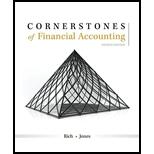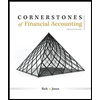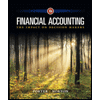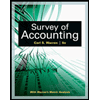
Characteristics of
Below is a common list of depreciation methods and characteristics related to depreciation.
Depreciation Methods
a.
b. Declining balance depreciation method
c.
Characteristics
1. Results in depreciation expense that decreases over the life of the asset.
2. Results in depreciation expense that increases over the life of the asset.
3. Allocates the same amount of cost to each period of a depreciable asset’s life.
4. Calculated by multiplying a constant depreciation rate by depreciable cost.
5. Calculated by applying a constant depreciation rate to the asset’s book value at the beginning of the period.
6. Results in lowest income taxes in early years of the asset’s life.
7. Consistent with the matching principle.
Required:
Match one or more of the depreciation methods with each characteristic.
Trending nowThis is a popular solution!

Chapter 7 Solutions
Cornerstones of Financial Accounting
- The straight-line method of depreciation allocates the cost of an asset more rapidly than the sum-of-the-years-digits method.arrow_forwardAn accelerated depreciation method that takes more expense in the first few years of the assets life is ________. A. units-of-production depreciation B. double-declining-balance depreciation C. accumulated depreciation D. straight-line depreciationarrow_forwardDepreciation of a plant asset is the process of ________. A. asset valuation for statement of financial position purposes B. allocation of the assets cost to the periods of use C. fund accumulation for the replacement of the asset D. asset valuation based on current replacement cost dataarrow_forward
- Using the information from EB7, calculate depreciation using the straight-line method.arrow_forwardWhich of the following represents an event that is less routine when accounting for long-term assets? A. recording an asset purchase B. recording depreciation on an asset C. recording accumulated depreciation for an asset or asset category D. changing the estimated useful life of an assetarrow_forwardWhich depreciation method ignores residual value when computing the depreciable base of an asset? a. sum-of-the-year's-digits b. double-declining-balance c. composite depreciation d. group depreciationarrow_forward
- Which depreciation method will compute the most depreciation expense over the life of the asset? O Declining-balance will produce the most depreciation expense. O Units-of-production will produce the most depreciation expense. O All methods will produce equal depreciation expense over the life of the asset. O Straight-line will produce the most depreciation expensearrow_forwardWhich of the following best describes an accelerated depreciation method? A. A method by which an equal amount of expense is assigned for every full year of use. B. A method by which depreciation is based on the level of actual usage rather than the passage of time. C. A method of determining depreciation which assigns larger expenses to the initial years of an asset’s service and smaller expenses to the later years. D. A method of allocating the cost of a wasting asset to expense over the periods during which the value is removed from the property.arrow_forwardThe depreciation method in which the depreciable cost of an asset is apportioned equally over its estimated life in terms of months or years is called the a.units-of-production method. b.straight-line method. c.declining-balance method. d.sum-of-the-years'-digits method.arrow_forward
- Which of the following is considered when depreciating an asset under the cost model? The cost of the asset. The change in the fair value of the asset. The useful life of the asset. Both a and b. Which of the following depreciation methods will most likely result in the highest amount of reported profit in the early years of an asset’s useful life? Straight line 150% declining balance Double declining balance Sum-of-the-years’ digits The most commonly used depreciation method is the straight-line method. replacement method. depreciation method based on revenue. inventory method.arrow_forwardThe depreciation method in which the depreciable cost of an asset is apportioned equally over its estimated life in terms of months or years is called the a.straight-line method. b.declining-balance method. c.sum-of-the-years'-digit method. d.units-of-production method.arrow_forwardWhich of the following best describes depreciation? A.ccounts for the market value of a physical asset B.Part of the cost of a physical asset allocated as an expense to each time period in which the asset is used. C.Shows the increase in value of a physical asset over the asset’s useful life D.Shows the drop in value of an asset when the asset is first used by an entityarrow_forward
 Cornerstones of Financial AccountingAccountingISBN:9781337690881Author:Jay Rich, Jeff JonesPublisher:Cengage Learning
Cornerstones of Financial AccountingAccountingISBN:9781337690881Author:Jay Rich, Jeff JonesPublisher:Cengage Learning Financial Accounting: The Impact on Decision Make...AccountingISBN:9781305654174Author:Gary A. Porter, Curtis L. NortonPublisher:Cengage LearningCentury 21 Accounting Multicolumn JournalAccountingISBN:9781337679503Author:GilbertsonPublisher:Cengage
Financial Accounting: The Impact on Decision Make...AccountingISBN:9781305654174Author:Gary A. Porter, Curtis L. NortonPublisher:Cengage LearningCentury 21 Accounting Multicolumn JournalAccountingISBN:9781337679503Author:GilbertsonPublisher:Cengage Survey of Accounting (Accounting I)AccountingISBN:9781305961883Author:Carl WarrenPublisher:Cengage LearningPrinciples of Accounting Volume 1AccountingISBN:9781947172685Author:OpenStaxPublisher:OpenStax College
Survey of Accounting (Accounting I)AccountingISBN:9781305961883Author:Carl WarrenPublisher:Cengage LearningPrinciples of Accounting Volume 1AccountingISBN:9781947172685Author:OpenStaxPublisher:OpenStax College College Accounting, Chapters 1-27AccountingISBN:9781337794756Author:HEINTZ, James A.Publisher:Cengage Learning,
College Accounting, Chapters 1-27AccountingISBN:9781337794756Author:HEINTZ, James A.Publisher:Cengage Learning,





